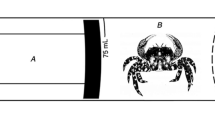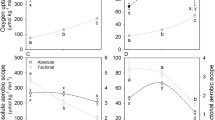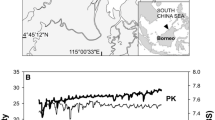Summary
Terrestrial and freshwater pulmonate snails exhibit a marked depression of aerobic metabolism during estivation. This is an adaptation for existence in periodically harsh environments and, though marine gastropods may undergo anaerobic metabolism, they have not been shown to adaptively depress aerobic metabolic rate. We compared the metabolic response to progressive aerial exposure of two intertidal gastropod limpets, a prosobranch and a pulmonate. The prosobranch Patella granularis maintained a constant heart rate until shortly before death. In contrast, the pulmonate Siphonaria oculus underwent facultative depression of heart rate, accompanied by a decline in oxygen consumption. Both heart rate and oxygen consumption returned to normal levels on reimmersion in water. Metabolic rate depression is energy conserving, and may account for the ability of S. oculus to extend higher up the shore than P. granularis, into areas where food availability is low. S. oculus is a primitive, marine pulmonate, periodically subject to harsh conditions, and its capacity for metabolic rate depression may represent a pre-adaptation for life on land.
Similar content being viewed by others
References
Barnhart MC, McMahon BR (1987) Discontinuous carbon dioxide release and metabolic depression in dormant land snails. J Exp Biol 128:128–138
Branch GM, Newell RC (1978) A comparative study of metabolic energy expenditure in the limpets Patella cochlear, P. oculus and P. granularis. Mar Biol 49:351–361
Branch GM, Borchers P, Brown CR, Donnelly D (1988) Temperature and food as factors influencing oxygen consumption of intertidal organisms, particularly limpets. Am Zool 28:137–146
Brinkhoff W, Stockmann K, Grieshaber M (1983) Natural occurrence of anaerobiosis in molluscs from intertidal habitats. Oecologia 57:151–155
Hammen CS (1980) Total energy metabolism of marine bivalve mollusks in anaerobic and aerobic states. Comp Biochem Physiol 67A:617–621
Kooijman D, van Zoonen H, Zurburg W, Kluytmans J (1982) On the aerobic and anaerobic energy metabolism of Littorina species in relation to the pattern of intertidal zonation. In: Addink ADF, Spronk N (eds) Exogenous and endogenous influences on metabolic and neural control. 2 Abstr Congr Eur Soc Comp Physiol Biochem 3rd, Pergamon Press Oxford, pp 134–135
Lowell RB (1984) Desiccation of intertidal limpets: effects of shell size, fit to substratum, and shape. J Exp Mar Biol Ecol 77:197–207
Machin J (1975) Water relationships. In: Fretter V, Peake J (eds) Pulmonates 1 Functional Anatomy and Physiology. Academic Press, London, pp 105–164
McMahon RF (1983) Physiological ecology of freshwater pulmonates. In: Russell-Hunter WD (ed) The Mollusca 6 Ecology. Academic Press, London, pp 359–430
Morton JE (1955) The evolution of the Ellobiidae with a discussion on the origin of the Pulmonata. Proc Zool Soc (Lond) 125:127–168
Pamatmat MM (1978) Oxygen uptake and heat production in a metabolic conformer (Littorina irrorata) and a metabolic regulator (Uca pugnax). Mar Biol 48:317–325
Solem A (1985) Origin and diversification of pulmonate land snails. In: Trueman ER, Clarke MR (eds) The Mollusca 10 Evolution. Academic Press, London, pp 269–294
Storey KB, Storey JM (1990) Metabolic rate depression and biochemical adaptation in anaerobiosis, hibernation and estivation. Q Rev Biol 65:145–174
Riddle WA (1983) Physiological ecology of land snails and slugs. In: Russell-Hunter WD (ed) The Mollusca 6 Ecology. Academic Press, London, pp 431–461
Trueman ER (1967) The activity and heart rate of bivalve molluscs in their natural habitat. Nature 214:832–833
von Brand T, McMahon P, Nolan MO (1957) Physiological observations on starvation and desiccation of the snail Australorbis glabratus. Biol Bull (Woods Hole, Mass) 113:89–102
Wieser W (1980) Metabolic end products in three species of marine gastropods. J Mar Biol Ass (UK) 60:175–180
Author information
Authors and Affiliations
Rights and permissions
About this article
Cite this article
Marshall, D.J., McQuaid, C.D. Metabolic rate depression in a marine pulmonate snail: pre-adaptation for a terrestrial existence?. Oecologia 88, 274–276 (1991). https://doi.org/10.1007/BF00320822
Received:
Accepted:
Issue Date:
DOI: https://doi.org/10.1007/BF00320822




